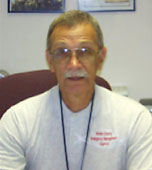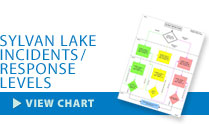Sylvan Lake EAP Case Study
The EMD's Perspective

Mike Newton,
Noble County EMD
"I'm a retired policeman from a nearby town, and I did not know a lot about the situation at Sylvan Lake or what the effects of a dam failure would be," Noble County EMD Mick Newton recalled. "As IEAP development team discussed various aspects of the plan, it was evident that if Sylvan Lake Dam were to fail, the impact would fall on the West Lakes area below and west of the dam. There are several hundred homes and businesses there. As we went through the planning process I became increasingly interested in how an emergency event should play out.
"The IEAP draft was well developed in terms of explaining the different phases and incidents, defining levels of events, when the situation gets critical, and developing a really good process to manage that, with some basic timelines for what has to be done and when. The Conservancy District will make the decision whether to open the Tainter gate, but they are not responsible for evacuations. The sheriff has that responsibility."
The U.S. Army Corps of Engineers (USACE) had been involved with the dam on a several occasions over the years. USACE provided inspections, recommended repairs, and developed phased plans for improvements needed to get the dam up to modern standards in view of its HHP designation. One of the plans included recommended evacuation procedures.
"It was a very technical, complete, and good plan," said Newton. "But Noble County is rural, with eight volunteer fire departments, seven law enforcement agencies, and one ambulance service. None of these agencies are staffed with surveyors or engineers, and the Corps language was a little too technical. I could see that it needed to be rewritten and restructured with layman's terminology and procedures that could be easily understood. If emergency responders don't understand something, they start freelancing to try and get the job done. This type of dam emergency response and evacuation would have to be carefully organized to be successful.
"The Corps plan had the fire department responsible for covering quarter-quarter sections of land, but our responders are used to streets and addresses. And we like to work with forms that are check lists. Do the task, visit the property, and check it off.
"As we worked through the IEAP and prepared for the tabletop exercise that would follow, I worked on the separate emergency response and evacuation plan that supplements the IEAP. The inundation map showed us the area we had to evacuate in a worse-case scenario. Working with Siavash we determined where the water would go, how high it would be and for how long. So now we had both area and elevation. The county GIS (Geographic Information Systems) identified every house above and below that elevation. It was sorted into a list by street."
The IEAP, inundation map, and the evacuation plan also tell first responders which blocks where people need to get out first. In some situations there may be only an hour or less to clear blocks that will be hit first.
The West Lakes area with hundreds of properties must be accessed from all four directions, none of which go straight through to the other side, so a volunteer fire department was assigned to each of the four zones. An Incident Command System was set up, with an organization chart showing an area command for each zone. The sheriff's role as zone commander is to coordinate the overall response. He will establish an Area Command Post with a representative of the Conservancy District board present. The board member will be providing him updates that will drive his evacuation decisions for each zone.
"Because we're rural, we also have to take into account the time of day when an incident at the dam may develop," said Newton. "Volunteers have day jobs, and that impacts the manpower available. You have to be flexible in planning so people can be shifted around to make certain the streets are covered. With a fire chief in charge of a zone, three-person teams are assigned to cover the streets and visit every house, mark the house regarding occupancy, and check it off their list." Rome City police will be available to the zone teams to help blocking streets and routing evacuation traffic.
With the plan configured to better fit the real-world emergency response system locally, the communication flow was next to address.
"The plan originally had the District calling everybody – the sheriff, the fire chief and so on," said Newton. "But we have an emergency response system so the only person who has to be contacted is the 911 dispatcher, who has a check list of multiple agencies to activate in response to different incidents. So we just had to lay out the IEAP decision process the Conservancy Board will be following and tell the dispatcher what the corresponding response will be.
"Each zone commander has his own book of instructions and check lists, and the leader of each team assigned to a street has the numerical list of the houses that have to be visited, check off what they did at each house, and whether anybody was at home. It creates accountability to make sure everyone is warned. We also ask each person leaving home to tell us where they will be going so we know what to tell friends and relatives who will call us when they learn of the emergency."
Last year a tabletop exercise introduced the IEAP and evacuation plan to all the volunteers at the eight fire departments.
"It was really an eye-opener to a lot of them," said Newton.
Another tabletop exercise included the scenario of a traffic accident that closes Highway 9. And that led to another eye-opener.
"This is a major highway, and there are no good ways to route traffic around the dam if the road is closed there," Newton said. "The economic impact could be major. It's not just people getting to and from work. The highway carries traffic to industries with just-in-time inventory systems. We had to sit down with the highway department and work out the detours. The road could be down for a long time if the dam has to be rebuilt. And we also didn't have a handle on all the signs and barriers that have to be ready and deployed quickly. We are in the process of developing all that now to improve the IEAP response."
The National Weather Service sends a representative to the exercises and provides mock forecasts and down-range data. This determines whether the crest of the lake's rise has arrived or is yet to come as responders get ramped up and ready to go on a moment's notice.
Newton hopes to have a full-scale functional exercise next year to simulate a dam failure. It is expected that information packets will placed on every door. This drill will be timed to see how long it takes to cover each block and zone. Further adjustments to the IEAP and the evacuation plan may be one result of the exercise. Other layers that need to be developed involve the recovery aspects of the response, such as bringing behavior health professionals to the Red Cross shelters to counsel displaced people who have lost their homes and may experience shock and despair.
"We could never have built a plan as good as this without the information in the IEAP to tells us what had to be done down below the dam," said Newton. "They did a great job of laying out what are the risks to the dam – flooding, earthquake, seepage, cracking, movement, overtopping, gate failure, blocked spillway. The IEAP gives us three levels of incident severity notification. Level 3 is closely watching lake levels and the dam. Level 2 means dam failure is likely within hours. Level 3 is, well, we're in trouble."
He noted that in addition to providing the basic IEAP template, DNR has been an excellent resource providing other information and guidance.
There are many more details built into Newton's plan, but he said the key to a successful response lies not just in the planning, but in the coordination and communication between all the people involved from different agencies – and keeping the plans fresh.
"These actions are tough enough to keep sharp when you do them daily. When you have something that may never happen or that is low risk of happening, you still have to be ready with a plan so you can brief people in 10 minutes or less and get on with the job," said Newton. "There have been issues that came up we never would have identified if we hadn't gone through this IEAP process and the exercises.
"All this has been a very positive process and a great learning tool. The IEAP and the evacuation plan were a major project, but the District people and the community are better prepared now. It would be more dangerous for lives and property below the dam if the District didn't have such a thorough plan. Plus, Leigh has a great handle on it and the District has a knowledgeable engineer on call. Now we can all see what trouble we would be in we didn't have this planned out, and it would have been scary."



